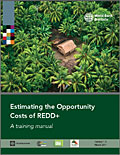World Bank REDD+ costs manual
-----------------
The World Bank Institute and Forest Carbon Partnership Facility have released a free 262-page manual for assessing the true costs of REDD+ action aimed at saving and restoring forests. “Estimating the Opportunity Costs of REDD+” is a guide for those formulating national avoided deforestation policies and programmes under the emerging global REDD+ framework being developed by the UN, World Bank and others.
The authors argue that help is needed to identify the hidden costs of reducing deforestation and degradation. While the transaction and implementation costs of programmes to preserve or restore forest are not hard to measure, the opportunity costs, or the losses from land-use activities foregone, are not so obvious. Deforestation most often results from land clearing for agriculture - growing crops or grazing livestock - often more valuable economic activities for the people of forest countries.
Knowledge of the economic value foregone in preventing their expansion into forest areas is “crucial” the authors argue; studies show they can be up to 95% of the costs of avoiding deforestation in the countries with the most forest cover; they show the drivers of deforestation; and they help identify the social impact of REDD+ activity and what compensation might be appropriate.
The target audience for the manual includes professionals in governments, universities, research institutions, international or non-governmental organisations and program developers . The handbook offers practical and theoretical steps, methods and tools to estimate the opportunity costs of REDD+ at the national level so they can be incorporated into recommendations for REDD+ policies and programs.
The IISD says the manual covers calculation of costs and benefits of the various land use alternatives in relation to their carbon stocks, as well as the identification of economic trade-offs involved in REDD+ activities. As required data are generally not readily available, the manual also includes information on data collection, analysis and evaluation techniques.
|
---------------


